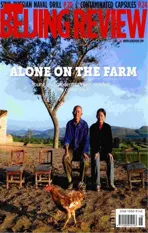MARKET WATCH
2012-12-23
MARKET WATCH
OPINION
Stable Track
China’s foreign trade stabilized in December 2011 thanks to selective easing policies in the country and recovering demand from other emerging economies.
Data from the General Administration of Customs showed that China’s exports totaled$174.72 billion in December 2011, up 13.4 percent year on year, 0.4 percentage points lower than in November. This was largely in line with market expectations. China’s exports to the United States slowed, but those to Japan and emerging markets remained stable.
The country’s imports stood at $158.2 billion in December, an increase of 11.8 percent from the previous year, down 10.3 percentage points from November. But imports of iron ore and soybeans maintained rapid growth. It is likely that China’s slowing import growth was in part due to falling international commodity prices.
The trade surplus increased to $16.5 billion in December from November’s $14.5 billion. The widening trade surplus may put pressure on the yuan to appreciate.
Overall, China’s foreign trade is running on a stable track, though imports slowed because cooling property markets depressed domestic demands.
In another move, the purchasing managers index, a barometer of manufacturing activities, stood at 50.3 percent in December, rebounding from 49 percent in the previous month. There’s evidence to believe that the Chinese economy has showed signs of stabilizing. If policymakers put appropriate monetary and fiscal policies in place, it is believed that the economy may accomplish a soft landing in the fi rst quarter of 2012.
We still maintain the forecast that the People’s Bank of China, the central bank,will lower the reserve requirement ratio three times this year. With the support of relatively easing policies, economic growth will bounce back in the second quarter. The growth rate for the entire year of 2012 will be around 9 percent.
In 2011, China’s imports of commodities such as crude oil and iron ore maintained a robust growth. The biggest bene fi ciaries were the OPEC nations, Australia and Canada.
The trade surplus for 2011 shrank to around $160 billion from $180 billion in 2010. The trade surplus would account for about 2.3 percent of the GDP in 2011, down from 3.1 percent in 2010. That shows the economy is weaning off reliance on external demand thanks to buoyant domestic demand and the country’s stiff efforts to transform its growth model.
We estimate that China’s exports will grow 13-15 percent in 2012, and imports will increase around 15-18 percent. The trade surplus is expected to drop to around$120 billion next year, making up only 1.5 percent of the GDP. That means China’s foreign trade will become more balanced.
Despite the falling trade surplus,the Chinese currency is facing growing pressures of appreciation. China has accumulated huge foreign exchange reserves in past years and invested much of the money in overseas assets, such as U.S. Treasury securities. China has also received interest and dividends from those investments, so its current accounts have constantly reported surpluses. That is an important source of pressures for the yuan to rise in value.
In the near term, the yuan will stay at a stable level against the U.S. dollar, but the possibility of appreciation is on the rise. We estimate the yuan will start appreciating in the second quarter, and appreciate by around 3 percent against the U.S. dollar in 2012.
THE MARKETS
IPO Craze
China remained the world’s biggest initial public offering (IPO) market in 2011, said PricewaterhouseCoopers (PwC).
Chinese firms raised a combined 286.1 billion yuan ($45.5 billion) via 282 IPOs in Shanghai and Shenzhen in 2011, 41 percent less than in 2010. A number of companies postponed their IPOs or slashed their fundraising target due to tepid demand.
PwC forecast that China’s IPO market would remain at the same level in 2012, raising 270 billion-300 billion yuan ($42.65 billion-$47.39 billion).
“Many Chinese companies are preparing for IPOs and waiting for the right time to go public,”said Frank Lyn, PwC China Markets Leader,adding that the IPO market will be driven by sectors including industrial products, retail, consumer goods and services, as well as financial service.
Dairy Suspicions
China’s top dairy manufacturers—Mengniu,Yili and Sanyuan—recently announced price hikes of as much as 10 percent, as a result of costs in fl ation.
“Since last year, the prices of raw milk,packaging materials, as well as labor and logistics costs have been on the rise,” said Sanyuan.
But the price increase has raised controversies given simmering worries over dairy safety in the country. In late December 2011, some pure milk products of Mengniu in Sichuan Province were found to be tainted with excessive amounts of a fl atoxin, a cancer-causing toxin. The scandal dealt a blow to consumer confidence, though Mengniu immediately apologized to the public.Mengniu’s sales in fi rst-tier cities have dropped 10-20 percent due to the image crisis.
“By hiking prices, dairy firms may try to fulfill sales targets for the upcoming holiday season,” said Wang Dingmian, President of the Guangdong Provincial Dairy Association. “The companies should give priority to quality, instead of pro fi ts.”
This is an edited excerpt of views of Liu Ligang, head of Greater China Economics, ANZ Banking Group, Hong Kong, published on the website ofCaijingmagazine
Correction:Beijing Reviewregrets an error made in issue No.2, 2012. On page 36, in the sentence “This is an except from an article inBusiness Reviewdated December 2011”, the word “except” should be “excerpt.”
